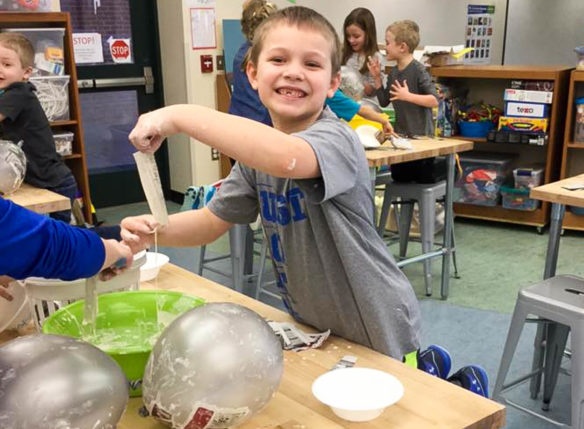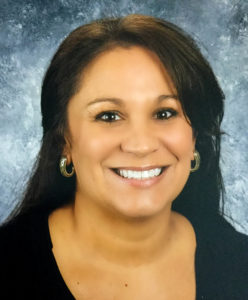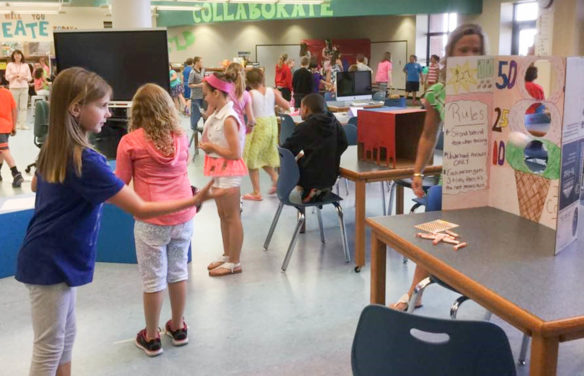
One of the highlights of the new library at Emma B. Ward Elementary School (Anderson County) is a makerspace that students can use to create class projects. First-graders like Wyatt Shouse learn about Dr. Seuss, then utilize the makerspace to create papier-mache figures of some of the author’s most famous characters.
Submitted photo by Tanya Blackhurst
“The change I’ve witnessed in the use of our library is remarkable. Our library is now a common space that can be used by any teacher throughout the year for project-based learning. It has given me the option to branch out and try new lessons that were not possible in a confined classroom space.”
– Lisa Hudson
5th-grade reading teacher at Emma B. Ward Elementary
By Tanya Blackhurst
tanya.blackhurst@anderson.kyschools.us
When students returned to Emma B. Ward Elementary for the 2015-16 school year, they noticed some big changes in their library. The new library embraces a 21st-century model, including a makerspace, a variety of technology, print materials, space for collaboration and movement, and a flexible library schedule in which the library is available to students throughout the school day.
The process of transitioning from the traditional library began during the 2014-2015 school year, when a group of teachers, librarians and administrators started brainstorming ideas for a creative commons area for the following school year. We wanted our school to have a common space that encouraged critical thinking, problem solving, collaboration and digital literacy in order to prepare students for a changing world.

Tanya Blackhurst
We visited other school libraries, read articles on flexible scheduling, brought in experts to give suggestions for our space and met with our school’s master scheduling committee before anything was purchased or changed. When everything was agreed upon and approved by our school-based decision making council, the plan was set into motion.
Thousands of books were weeded and moved, shelves were broken down and repurposed, casters were attached to shelves and tables, and collaboration on project-based learning ideas between the media specialist and teachers began to happen. The Anderson County Maintenance Team and school media specialist spent the summer renovating the library.
We no longer have large, bulky bookshelves taking up the majority of the space or rows of tables with desktop computers. Much of the new technology was provided by district technology funds and distributed by our chief information officer for this project. Many computers were refurbished and repurposed. The space is open, furniture is easily movable and our library is more conducive to collaboration.
One of the highlights of our library is a makerspace students can use to create class projects. The shelves are stocked with paper towel rolls, coffee cans, egg cartons and other consumables students might need. The makerspace reflects our need for balance between rigorous learning opportunities and creative thinking.

Movable furniture and an open design were key to the redesign of the library at Emma B. Ward Elementary School (Anderson County). The extra space allows for more schoolwide events to take place in the library, such as this 2nd-grade carnival, where students created games and invited their fellow classmates to play them.
Submitted photo by Tanya Blackhurst
The library also lends itself to collaboration among students, which is a cornerstone of the 21st-century learning model. In one area we have a large whiteboard wall where students can gather to brainstorm, share, create and plan with their peers. Another new component is a media room, equipped with a green screen and recording elements.
In addition to our new look, the library schedule is completely flexible. We have found instead of a schedule that best suits teachers, the new flexible library schedule is best suited for student needs.
Before, students had library access once per week. Library, research and technology skills were taught in isolation, not necessarily complementing classroom instruction. Now, students visit the library when they need a book or to work on a project or test. Teachers sign up to bring their classes for direct library/technology instruction on specific topics when the time is right for them to learn those skills.
This new space is all about serving the students’ needs. Students are drawn to our new, inviting and relaxing library. They have opportunities to learn things they might not otherwise encounter in a traditional library, classroom or even at home. We now have a library conducive to different learning styles and is always available to students and teachers. Our model puts students first and allows for exploration, creativity, collaboration, imagination and so much more.
Tanya Blackhurst is library media specialist at Emma B. Ward Elementary School (Anderson County).




All educators in Kentucky need to read and embrace this mindset of how our students learn best. Elementary Teacher-Librarians have been tooting this horn for some time. Great article!